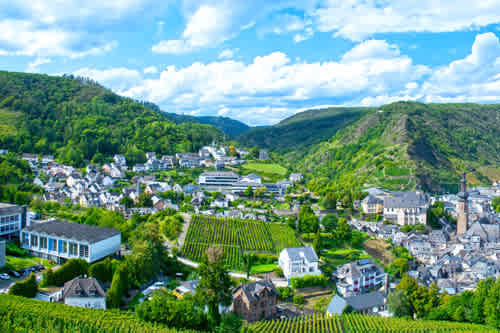Trier (formerly known in English as Trèves or Triers) is without a doubt the queen of the Moselle Valley.
About Trier
Trier is most probably the oldest town in Germany, founded in 16 BC during the reign of Roman Emperor Augustus. The river Moselle creates borders as it flows through three countries – France in the north-east, Germany in the south-west and Luxembourg in the east. It empties in Belgium – a fourth country! Trier, from Roman times, has always been the seat of a bishop and is one of the oldest dioceses in all of Germany. A tour of the city brings us in touch with marvelous historical monuments. The city is home to one of the oldest universities – yet one of the youngest! How can that be you ask? In 1473 the University was founded but closed in 1798 and in 1970 a new university was founded in its stead.
In 1986 the buildings of The Roman Monuments, the Cathedral of St. Peter which was built above the ruins of a former palace from the Roman era and the Church of Our Lady (Liebfrauenkirche) were listed together as a UNESCO World Heritage Site.
Undoubtedly, a landmark in the city and one of the important sites in Trier is the Porta Nigra (Latin for Black Gate). It dates back to the second century and is an enormous, fortified gate in the Roman town walls which are amazingly well preserved. It was made of sandstone, around 170 AD and was one of the four entrance gates to the city. The original gate was layered with slabs of tiles or marble and had a tiled roof. Over the years, a black patina had accumulated on the structure giving it its name and special look. (Patina is a chemical process that occurs naturally when metal is left to the elements and changes color when exposed to air.)
The cladding and the roof were looted during the Middle Ages, which does not make the structure any less impressive and gives one a glimpse into the power of the Roman Empire, ruling here at the beginning of the first millennium AD.
Standing in front of the gate, you can see a kind of ecclesiastical "apse" attached to its left side and a spire that is missing as a result of its transformation from a gate into a church building in 1035 AD. Napoleon Bonaparte, who conquered the city in 1802, ordered the restoration of the gate.
Trier’s shopping streets all lead to Hauptmarkt, which is an exciting central square and is the city’s largest plaza where events and festivals take place and where you will find market stalls as well. It has been and still is a location where trade used to take place, since the Middle Ages
The impressive Cathedral of Trier is one of the most important in Germany and has always been the seat of a bishop since Roman times, one of the oldest dioceses in all of Germany. There is so much to see here including stone carvings, marble work and of course not to be missed is the room of reliquaries. The most treasured relic is the Tunic of Christ, the Holy Robe which is said to have been brought by Helena, the Emperor’s mother. Since the renovation of the Roman Catholic Cathedral in 1974, the Holy Robe is guarded in a wooden-temperature-controlled glass shrine. The cathedral was badly damaged in WWII and reopened in 1974. When going out of the cathedral you will see the impressive Gothic "cloister".
For a better understanding of this era, a visit to the Rheinisches Landesmuseum covers the history of Trier, especially during the Roman times. As well, you can see the world’s largest Roman gold coin collection
Weberbach street leads to the Kaiserthemen where the Romans constructed bathing complexes similar to the ones in Rome. From there, across the main road from Weimarer Alee is the Roman amphitheater.
As we get away from the incredible Cathedral we can visit the home where Karl Marx, the renowned communist revolutionary was born on May 5, 1818. The Baroque-style home on 10 Bruckerstrasse dates back to the early 18th century and is now a museum devoted to Karl Marx. The house contains an exhibition that represents capitalist social ideas of the 19th century.
If we continue from the house to Karl Marx Street, we will reach the Roman bridge Romerbruke which crosses the Moselle. The pillars date back to the second century and they too were built of massive stone blocks that were attached one to the other with iron clamps. Without crossing to the other side, we will stroll along the bank on the promenade along the Moselle River and enjoy the view and ponder the history of these incredible memories of the past.
Note: Do you know what was the original Roman name for the Black Gate? Augusta Treverorum
Secret: Standing on the Bridge, perhaps you too would like to throw a coin into the Moselle River as the locals did and do… to make an offering to the goddess Mosella and perhaps even make a wish!
Popular Itineraries
Traveled by thousands
Trier Hotels
by

Looking for some interesting things to do in Trier? Here are some recommended attractions and sights for you.
tours, sightseeing & cruises
outdoor activities
Attractions in Trier
- Amphitheater, Trier
- Cathedral, Trier
- Kaiserthermen, Trier
- Porta Nigra, Trier
- Rhineland Museum, Trier
- Historic Center, Trier
- Basilica of Constantine, Trier







 Travel Perks
Travel Perks